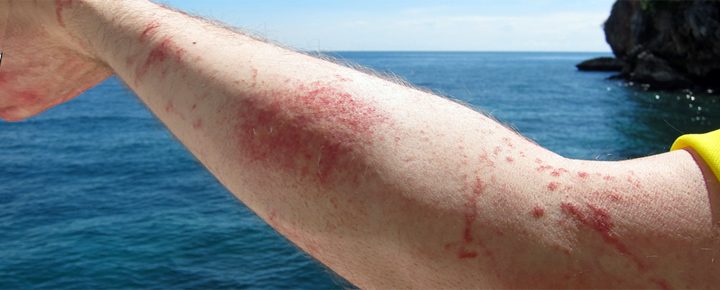A box jellyfish advisory remains in effect today for Waikiki Beach, Ala Moana Beach and Maili Beach, Oahu, and at Poipu Beach and Salt Pond Beach, Kauai, as they were widely seen on south facing beaches. Warning signs were posted and beachgoers are being warned to not go into the water.
“Why are they appearing at this particular part of the lunar cycle? Where do these box jellyfish come from and where are they found the rest of the lunar cycle? Why has this become a monthly problem in only the last 30 years?” These are the issues that the latest study addresses.
Researchers at UH Manoa today released a 10 year study on Hawaiian box jellyfish.
The box jellyfish study determined that “a key number of hours of darkness during the lunar cycle” is what triggers jellyfish to swim to shore.
UH said that “this work is very important to the state in terms of planning and tourism as well as improved signage, public awareness and dissemination of evidence-based jellyfish sting care.” Having had our share of jellyfish stings, we concur.
University of Hawaii’s School of Ocean and Earth Science and Technology (SOEST) together with the John A. Burns School of Medicine, have now studied local box jellyfish for over two decades. While scientists have used the approximation of 8–10 days following a full moon as the time when south-facing Hawaii shores are likely to see jellyfish, there’s been a lack of scientific research.
Groundbreaking Hawaiian box jellyfish study.
Researchers said that “We found that the dangerous monthly shoreline appearance of the Hawaiian box jellyfish, correlates with the specific nights of the lunar month—referred to as Kaloa in the Hawaiian calendar—with a critical number of hours of darkness after sunset and before moonrise.”
Reproduction is key to shoreline aggregation of jellyfish.
Researchers say that the jellies at the beach are actively spawning. In other words, “they were nearshore to reproduce.”
Fascinating indications were that “the period of the lunar cycle with a key number of hours of darkness or the ‘absence of light’ cues mature animals to specifically swim to the shore line to spawn… Their swimming speed and power was impressive!”
The study focused on jellyfish on Oahu, although much of the findings apply those found on the other islands, such as Kauai, were there was an outbreak this week. On Oahu, researchers now believe that jellyfish largely live on the leeward side of Diamond Head, which provides food and shelter.
Only Hawaiian box jellyfish species exhibit this specific behavior.
The study found that even though there are over 40 species of jellyfish globally, this “is the only species that exhibits this clockwork lunar spawning migration behavior.” The same box jellyfish we find in Hawaii are also seen in Saipan, Puerto Rico, and Key West.
Further studies lie ahead, including efforts to help predict and inform regarding jellyfish, which are becoming increasingly concerning for those swimming and even walking on the beach on south facing shores.
See Hawaii Jellyfish Sting Warnings | Important Dates For Your 2022 Vacation.




Many years ago while swimming in Waimanalo my young son came screaming out of the water with jellyfish bites on him. A local guy said my husband should urinate on impacted areas, which he did, and my son calmed down completely! Don’t know if this was standard practice in the past, but it worked!!
We have seen tiny jellies while snorkeling off Maui in the fall/winter. Learned about the lunar jelly activities long ago so would watch for them during those days. Never snorkeled at night; saw them during the day. Beautiful … so graceful.
Being stung by a box jellyfish causes pain like no other. Please avoid these at all cost! The intense burning sensations are horrible and lasted for hours. If you get stung and are allergic, please seek medical care immediately!
I got hit yesterday morning surfing Sui’s, 5/25. My arm looked just like the picture in article
Run the hottest water that you can stand over the affected area when you get home
Instant relief
Then hot water soaked wash cloth. Works amazing.
Aloha Beat of Hawaii!
A couple of observations about life in Hawaii.
#1 Signs matter
#2 Jellyfish are only in and near water.
#3 Refer to #1.
Sorry, not sorry 😂🤣💕🌺
Mahalo for all you do
I work at a condo complex on Sugar Beach on Maui and our guests have had several jellyfish stings in the past week. This is helpful to know what is going on!
Quite the unpleasant thing to have happen. I swam in to some.and got stung on my forehead. Fortunately my mask was covering a lot of my face so not near as bad as what happened to ex2 and her ample cleavage but I’ll leave it at that. And yes, I have been vacationing in Hawaii for over 30 years and anytime I was there during that 8 to 10 day period they were out in abundance, and also sometimes outside of those days too.
and just like the anti maskers people will ignore the warnings to stay out of the water and end up getting stung or whatever jellyfish do. I saw it personally right in oahu. Signs, lifeguards etc dont go in! But my freedom!
Ahh yes…the infallible science regarding strapping cotton to your face. How dare they question it.
Yes I have. In March of 2021 at Lanikai Beach. Small blue one. Stung like hell!